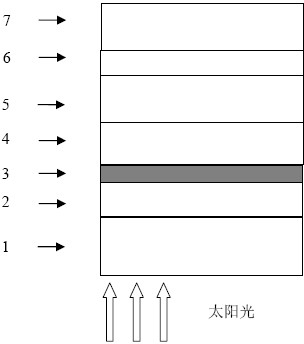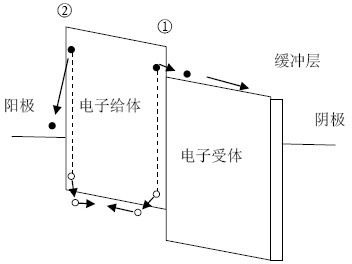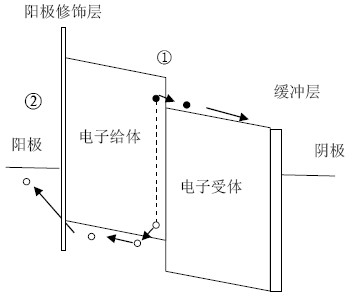A kind of organic solar cell and preparation method thereof
A solar cell, organic technology, applied in circuits, photovoltaic power generation, electrical components, etc., can solve problems such as difficulty in control, and achieve the effect of improving energy conversion efficiency
- Summary
- Abstract
- Description
- Claims
- Application Information
AI Technical Summary
Problems solved by technology
Method used
Image
Examples
Embodiment 1
[0042] figure 1 It is the structural diagram of embodiment 1 of the present invention, and transparent insulating substrate 1 adopts quartz glass; Transparent electrode 2 adopts FTO stripe electrode, and its sheet resistance is 20 ohms / □; Anode modification layer 3 adopts SiO2 silicon dioxide material; Layer 4 adopts CuPc copper phthalocyanine thin film; second photosensitive layer 5 adopts C60 thin film; buffer layer 6 adopts organic material Alq3 thin film; high reflectivity electrode 7 adopts Al aluminum thin film electrode.
[0043] Prepare as follows:
[0044] Polished quartz glass with a thickness of 1.1mm is selected as the transparent insulating substrate 1, and the quartz glass is cleaned for 2-3 hours by ultrasonic method;
[0045] A layer of ITO conductive film is grown on one side of the quartz glass by sputtering as the transparent electrode 2, and the thickness of the ITO film is 100nm;
[0046] Photolithographically etch the ITO conductive film into the requi...
Embodiment 2
[0054] See figure 1 The transparent insulating substrate 1 adopts quartz glass; the transparent electrode 2 adopts ITO stripe electrodes, and its square resistance is 15 ohms / □; the anode modification layer 3 adopts LiF lithium fluoride material; the first photosensitive layer 4 adopts CuPc copper phthalocyanine thin film; The second photosensitive layer 5 is made of C60 thin film; the buffer layer 6 is made of organic material Alq3 thin film; the high reflectivity electrode 7 is made of Al aluminum thin film electrode.
[0055] The specific preparation is as follows:
[0056] Polished quartz glass with a thickness of 1.5mm is selected as the transparent insulating substrate 1, and the quartz glass is cleaned for 3 hours by an ultrasonic method;
[0057] A layer of ITO conductive film is grown on one side of the quartz glass by sputtering as the transparent electrode 2 . The thickness of the ITO film is 120nm;
[0058] Photoetching the ITO conductive film into the required...
Embodiment 3
[0066] like figure 1 , the transparent insulating substrate 1 is made of quartz glass; the transparent electrode 2 is made of ITO stripe electrode, and its square resistance is 17 ohms / □; the anode modification layer 3 is made of TiOx material; the first photosensitive layer 4 is made of pentacene film; the second photosensitive layer 5 adopts C60 thin film; buffer layer 6 adopts organic material BCP thin film; high reflectivity electrode 7 adopts Ag silver thin film electrode.
[0067] Prepare as follows:
[0068] Polished quartz glass with a thickness of 3.2mm is selected as the transparent insulating substrate 1, and the quartz glass is cleaned for 4 hours by ultrasonic method;
[0069] A layer of ITO conductive film is grown on one side of the quartz glass by sputtering as the transparent electrode 2 . The thickness of the ITO film is 150nm;
[0070]Photoetching the ITO conductive film into the required striped electrode pattern as the anode of the solar cell;
[0071...
PUM
| Property | Measurement | Unit |
|---|---|---|
| Thickness | aaaaa | aaaaa |
| Thickness | aaaaa | aaaaa |
| Thickness | aaaaa | aaaaa |
Abstract
Description
Claims
Application Information
 Login to View More
Login to View More - Generate Ideas
- Intellectual Property
- Life Sciences
- Materials
- Tech Scout
- Unparalleled Data Quality
- Higher Quality Content
- 60% Fewer Hallucinations
Browse by: Latest US Patents, China's latest patents, Technical Efficacy Thesaurus, Application Domain, Technology Topic, Popular Technical Reports.
© 2025 PatSnap. All rights reserved.Legal|Privacy policy|Modern Slavery Act Transparency Statement|Sitemap|About US| Contact US: help@patsnap.com



